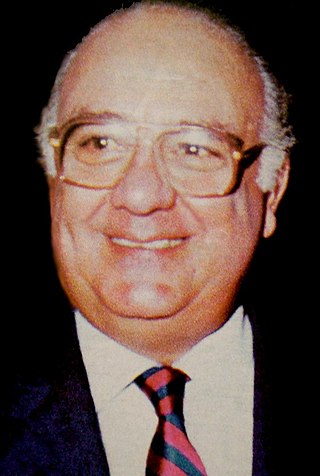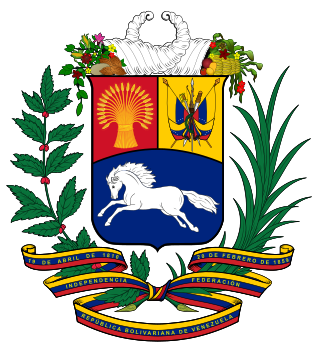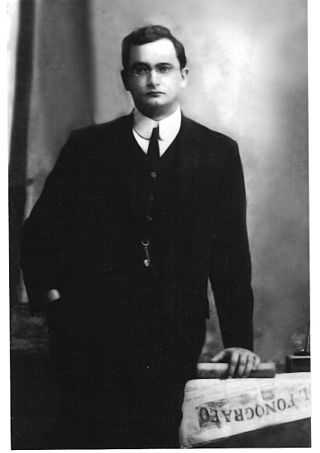
Jaime Ramón Lusinchi was the president of Venezuela from 1984 to 1989. His term was characterized by an economic crisis, growth of the external debt, populist policies, currency depreciation, inflation and corruption that exacerbated the crisis of the political system established in 1958.

The Palacio de Miraflores is the official residence of the President of Venezuela. It is located on Urdaneta Avenue, Libertador Bolivarian Municipality in Caracas.

Victorino Márquez Bustillos, was a Venezuelan lawyer and politician, and was provisional president of Venezuela from 1914 to 1922. Although Bustillos was elected by Congress, General Juan Vicente Gómez remained the real power behind the presidency. Victorino Márquez died in Caracas on 10 January 1941, aged 82.

Germán Suárez Flamerich was the president of Venezuela from 1950 to 1952. Flamerich was a lawyer, college professor, diplomat, and politician. He was president of the Government Junta from 1950 to 1952, after the assassination of Carlos Delgado Chalbaud.

The Cabinet of Ministers of Venezuela (Spanish: Gabinete de Ministros de Venezuela is one of the bodies that make up the Venezuelan executive in that country's presidential system, alongside the Council of Ministers. The Cabinet is headed by the president of Venezuela, and his corresponding vice president. The purpose of the ministries is to create, adopt, follow and evaluate policies, strategies, programs and projects in accordance with the constitution and the laws of the republic.

The Central University of Venezuela is a public university located in Caracas, Venezuela. The university is widely regarded as the highest ranking institution in the country. Founded in 1721, it is the oldest university in Venezuela and one of the oldest in the Western Hemisphere. It is ranked 18th among the universities in Latin America.

The history of Venezuela reflects events in areas of the Americas colonized by Spain starting 1502; amid resistance from indigenous peoples, led by Native caciques, such as Guaicaipuro and Tamanaco. However, in the Andean region of western Venezuela, complex Andean civilization of the Timoto-Cuica people flourished before European contact.

Rafael Simón Urbina López was a Venezuelan rebel who fought against the dictatorship of Juan Vicente Gómez.

Isaías Medina Angarita was a Venezuelan military and political leader, the president of Venezuela from 1941 until 1945, during World War II. He followed the path of his predecessor Eleazar López Contreras, and ruled the country's democratic transition process.
El Trienio Adeco was a three-year period in Venezuelan history, from 1945 to 1948, under the government of the popular party Democratic Action. The party gained office via the 1945 Venezuelan coup d'état against President Isaías Medina Angarita, and held the first democratic elections in Venezuelan history, beginning with the 1946 Venezuelan Constituent Assembly election. The 1947 Venezuelan general election saw Democratic Action formally elected to office, but it was removed from office shortly after in the 1948 Venezuelan coup d'état.
Between 1908 and 1958, the Republic of Venezuela saw several changes in leadership, including a coup d'état in 1948. The period also found the country discover its petroleum deposits, which has had a major effect on the economy of Venezuela

Eduardo López Bustamante was a Venezuelan journalist, lawyer and poet. He was a leading intellectual of the Zulia State, Venezuela, and a figure within Venezuelan jurisprudence.
Presidential elections were held in Venezuela on 28 April 1941 to elect the successor of President of Venezuela Eleazar López Contreras. This presidential election, unlike the elections held since 1947, was indirect, that is, the voters were the deputies and senators of the Congress of Venezuela. The winner on this day was Isaías Medina Angarita with 120 votes, 87.6% of the seats in the Congress.

The 1936 Venezuelan presidential election was held in Venezuela on 28 April 1936, to elect the successor of deceased President of Venezuela Juan Vicente Gómez. This presidential election was indirect, that is, the voters were the deputies and senators of the Congress of Venezuela. The winner on this day was provisional president Eleazar López Contreras with 121 votes, 98.37% of the seats in the Congress, who was elected as president for the 1936–1943 constitutional period.
This is the list of members elected in the 2017 Constituent National Assembly of Venezuela following the 30 July 2017 elections. The first session of the assembly began on 4 August 2017 in the Oval Room of the Palacio Federal Legislativo. The Democratic Unity Roundtable—the opposition to the incumbent ruling party—also boycotted the election claiming that the Constituent Assembly was "a trick to keep [the incumbent ruling party] in power." Since the opposition did not participate in the election, the incumbent Great Patriotic Pole, dominated by the United Socialist Party of Venezuela, won almost all seats in the assembly by default.
Democracy in Venezuela refers to the system of governance that has prevailed in Venezuela since direct election at the presidential level and later in the 1990s at the regional level. Democracy as a system of government in the country has had a history interrupted by coups d'état, some in the name of democracy itself. From 1958 onward, Venezuela was considered to be a relatively stable democracy within a continent that was facing a wave of military dictatorship, consuming almost all Latin American countries in the 1970s. By 1977, Venezuela was the only one of three democracies in Latin America, along with Colombia and Costa Rica. With the election of Hugo Chávez in the 1998 presidential election, the country started experiencing democratic backsliding. In 2008, Venezuela was ranked the least democratic nation in South America in The Economist Democracy Index, and by 2022 it ranked 147th out of 167 countries, with a rating of an authoritarian regime.
Eumelia Hernández was a Venezuelan feminist activist, and unionist. She was a founding member of the Feminine Cultural Association and the Vice President of the Central Unitary of Workers of Venezuela.

Juan Bautista Fuenmayor Rivera was a Venezuelan politician, lawyer, university professor and historian. He was general secretary of the Communist Party of Venezuela (1937–1946) and rector of the University of Santa María University (1977–1989).

The Constitution of Venezuela of 1936 was approved on July 16, 1936 during the presidency of Eleazar López Contreras. Its importance is centered on being the first political constitution of the State after the dictatorship of Juan Vicente Gómez. Although it put an end to the personalist character of its predecessors, at the beginning it had more restrictive characteristics than the seven Gomez constitutions, until April 23, 1945, when President Isaías Medina Angarita promoted a reform, deepening the democratization process that had begun in 1936. On October 18, 1945, a coup d'état planned by the military sector and supported by Democratic Action overthrew Medina. The new Revolutionary Government Junta calls for constituent elections in 1946, which leads to the approval of the 1947 Constitution, repealing the 1936 Constitution.
Various protests occurred against governments in Venezuela in the twentieth century.















